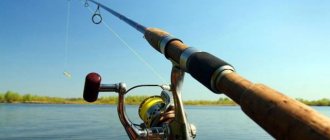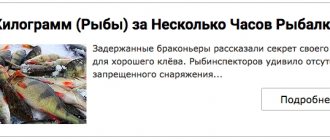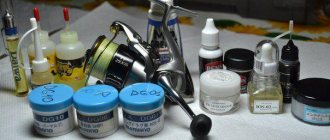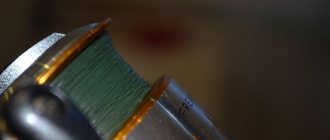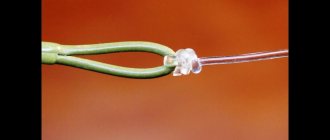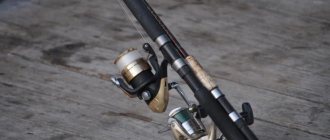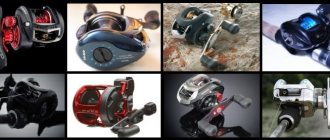As the main fishing line, feeder braid is used by most anglers. The reason is the zero elongation of braided fishing line compared to monofilament. This feature directly affects the sensitivity of the gear - the bite is registered at any fishing distance. Not every braided line is suitable for a feeder - it all depends on the fishing tasks and the characteristics of the equipment, and the conditions of the reservoir. In this article we will look at what cord is needed for the feeder and how to use it correctly.
Cord in feeder equipment
Braid is a polyfiber composite line woven from amide or nylon fibers impregnated with special compounds. Unlike monofilament fishing line, cords can withstand much greater tensile loads without stretching. It is these qualities that determine the choice of feeder braid as the main fishing line, especially for fishing distances over 30 meters. Even a rigid feeder line at such distances conceals bites, and careful pulls can simply not be noticed.
The feeder cord is the basis of the equipment, the link between the rig and the fishing rod. This is a piece of equipment that is constantly working under load. Feederists choose braid because of its inextensibility. However, the rigidity of the main line is a double-edged sword. When fishing for large fish, especially if the leashes are thin, the braided equipment does not absorb shock, so there is a high probability of breakage. Therefore, monofilament based in the feeder is also used, and sometimes monofilament is a necessity.
Tying the fishing line to the spool
Let's find out how to tie the fishing line to the spool.
The first rule is that tying the fishing line or backing to the spool is mandatory . You don’t know what kind of trophy you will come across, and it will be a shame if during the process of fishing the entire main line and backing unwinds, and there is no last line to hold the fish.
The fishing line can be tied with various knots: “arbor knot”, “self-tightening double loop”, “clinch”. On the first turn of fishing line or backing on the spool, you must additionally glue a piece of electrical tape or adhesive tape in the direction of winding. This will prevent the line from spinning on the spool, both during winding and when landing fish.

How such knots are tied in practice can be seen in the video:
Braid or fishing line
What is better for a feeder – braid or fishing line? This question is often asked by beginning feeders. And there is no clear answer. In some conditions it is better to use braid, in others - monofilament.
For long casts in the current you need high-quality thin braid. A thin-diameter cord has less windage, so the feeder is not pulled down by the flow. In a strong flow, it will not be possible to fish with a monofilament at distances of 40 meters or more - even heavy feeders will be pulled by the current. The loop inflated by the current and the stretchability of the monofilament will not allow you to properly record bites. A thin braid has a better reach, and the maximum cast can be made further. A thin line behaves better in the wind and improves casting accuracy.
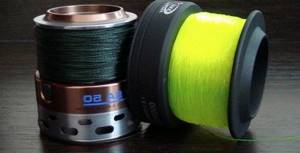
However, the cord is much more expensive, sometimes several times more. For close-range fishing on pickers or medium feeders, you can use a hard monofilament. We also install monofilament under the following conditions:
- In winter, autumn or spring in the cold. In such conditions, the braid freezes, gets tangled, and gets stuck in the rings.
- In the spring, when the river carries fluff, mud and algae. Debris sticks to the braid, also clogging the rod guides.
- Targeted fishing for large carp, carp or grass carp in ponds and lakes, without current. Monofilament is needed when fishing, as it absorbs the jerks of strong fish.
- During the initial development of the feeder, if fishing is carried out over short distances with cheap gear. When worked intensively, thin braid saws through low-quality rings and then cuts itself on these grooves.
The issue of using monofilament is discussed in more detail in the article about fishing line for the feeder. In this publication we will dwell in detail on the issue of braided lines in feeder fishing.

The thread tension on the bobbin is adjusted with a screw on the cap
The spring plate is adjusted with a small screw. Using this adjustment on the cap, you can increase the tension (for thin threads) or loosen it for thick threads. But it is advisable to adjust the tension of the lower thread less often, and adjust the stitching by adjusting the tension of the upper thread. And only in emergency cases, when the tension cannot be adjusted in any other way, can this spring be tightened or weakened.
If you have to tighten or unscrew a screw, then you cannot unscrew it more than half a turn. It can pop out and it will be very difficult to find it, and even more difficult to insert it back.
Braided cord as a base
A feeder cord is needed in some conditions, while in others it is better to use monofilament fishing line. Therefore, the packaged feeder has reels with two spools. A cord is wound on one, a fishing line is wound on the other. Some feeder reels are specially supplied with one shallow spool - a match spool for thin braid, and a second - a regular deep spool, for thicker fishing line. Therefore, when choosing a feeder coil, this point is taken into account. If the reel does not come with a spare spool, you need to buy a second one of the same kind in order to have a supply of equipment on both the fishing line and the braid. On a pond we simply install another spool and get another equipment.
Fishing conditions for which braid is needed in the feeder can be roughly divided into two groups. This is equipment for long casts, fishing in the current (large or medium-sized deep-water rivers for bream, crucian carp, carp and any other fish). The second group of conditions is all other cases. The difference is in the requirements for the cord. In the first case, you need to think carefully and choose a really good thin cord and use a shock leader on long casts with heavy feeders. In the second, the requirements for the braid are lower; almost any cheap cord, like for a donkey, will do. Of course, in close-range pickerel fishing it is also better to use good braided lines. However, it is possible to work at such a distance with any cords, as long as they do not break; at the same time, at a long distance in current conditions, you cannot do without the correct braid.
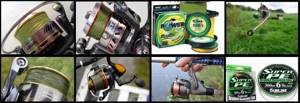
Long distance
Difficult fishing conditions affecting the choice of cord for the feeder:
- Long casts - a fishing distance of over 40 meters, sometimes 80-90, on the verge of the possible distance at which you can place the feeder at one point and record bites. The reach of a thin braid is better, it allows you to make the longest cast.
- Current - with a thick fishing line at such a distance, the feeder simply will not stay in the water.
- Wind - a feeder on a thick fishing line does not penetrate the lateral influence of air well, it is difficult to get to the point.
These nuances force the use of thin braiding, 0.09-0.12 mm. However, the loads during such fishing are high - heavy feeders, power casts, reeling from under the edge, shells and stones at the bottom, which injure the braided line. Therefore, you need a good thin cord with a high breaking load, at least 5.5 kg, and preferably 7 or 10, and resistance to abrasive. In order not to tear the thin braid on a powerful cast, we make a shock leader in the rig from a more powerful thread 0.19-0.22 mm or monofilament 0.3 mm.
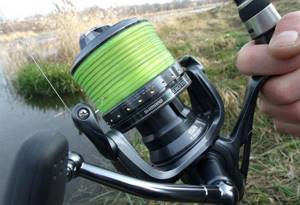
Such fishing conditions are a characteristic feature of the feeder, the equipment of which allows such fishing. Donks simply cannot reach such points. Therefore, the feeder, other things being equal, is more catchy. It allows you to fish from the shore where you can only reach with donkeys by boat. However, long-range equipment needs to be monitored and maintained, as it is subject to extreme loads.
The section of the braid in the working lower part (about five meters) must be constantly checked visually and by touch for damage, and updated in a timely manner, cutting off suspicious areas. The shock leader needs to be tied after every fishing, since the knot hits the rings when casting and wears out the cord in this place. When power casting, the quality of the braid is important - the cord must hold jerks in the clip and not break in it during a power cast.
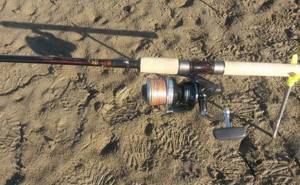
Therefore, for such fishing you need thin, good braids that are resistant to jerking loads, as for jigging or twitching. At the same time, the braid needs to be slippery and smooth for good reach when casting. Cheap Chinese fakes will not work - you will simply lose your arsenal of feeders when shooting. We will consider further what diameters and breaking loads to set for specific gear and fishing conditions.
Other conditions
For a feeder that is not used in extreme conditions in terms of range and current, you can use any cords capable of throwing a feeder up to 120 grams over a distance of up to 60 meters. The thickness of the braid for the feeder in such conditions, especially if there is no strong current, may be greater. Therefore, lower quality braids are suitable. The lack of breaking load is compensated by thickness. Typically four-core PE4 braids are used. Such threads are usually flat, with a large weaving pitch, so they rustle in the rings when casting. For a 100 gram feeder, the breaking load is approximately 4-5 kg for casts up to 40 meters and 6-7 kg for a distance of up to 60 meters. For longer distances, 60-80 meters, you will need a good, smooth, thin cord, discussed in the previous paragraph.
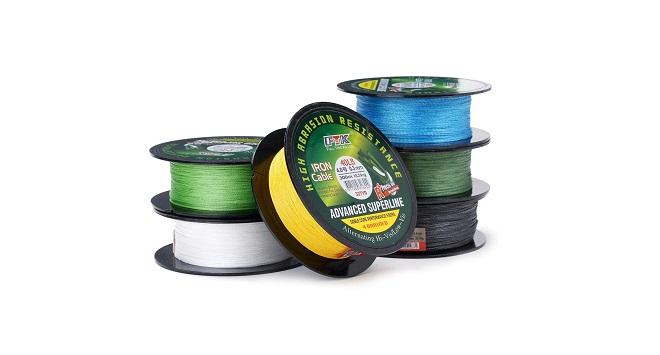
How to choose feeder braid? For close-range fishing up to 60 meters in conditions of weak or moderate current, you don’t have to worry too much about the quality of the braid. Any one will do, including cheap Chinese ones, as long as it’s durable. Diameters – about 12-0.14 mm. Beginners or those moving to the feeder often use ropes of about 16-0.18 mm, and catch successfully.
However, if an angler is aiming to create a fully functional, reliable and comfortable feeder for any fishing conditions, including difficult ones, with currents and long power casts, you will need a good thin braid.
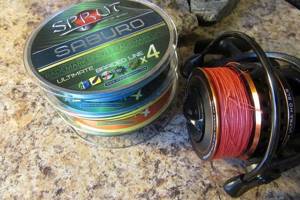
Knots for tying a hook to a braided line
"Clinch"
This is one of the easiest units to install. It is especially popular among spinners. Since they often have to tie spinning baits while fishing.
It fits like this:
- A fishing line is threaded into the eye of the fishing bait and pulled out about ten centimeters.
- The stretched line is folded in half and twisted six or ten turns.
- The free end is threaded between two fishing lines into a hole located near the eye of the bait.
"Palomar"
This is a simple and reliable way to attach a fishing hook to a leash. This is a very durable and reliable method that is used by a large number of anglers.
After the fishing loop is threaded through the eye, you need to tie a simple knot in the resulting loop. This will cause the loop to pass through the hook and tighten around the loop under the eye. After tying, the hook will be able to rotate freely on the resulting knot.
It fits like this:
- The leash is folded in half to create a flat, open loop.
- The bent end is passed through the eye of the hook.
- A simple knot is tied with the same end of the fishing line.
- The bend of the leash is passed over the hook and into the girth of the knot.
Using it, it is very convenient and practical to tie a fishing line or fishing line.
Feeder braid parameters
Which braid is better for the feeder? To understand this, the angler needs to understand the characteristics and varieties of braids. Some fishing resources recommend using a sinking feeder cord. This wattle fence is impregnated with a special compound. A sinking line actually sinks better in water. However, its use is not practical in intensive, especially recreational fishing. Sinking feeder braid quickly loses its properties, and is more expensive than usual. An amateur does not have the opportunity to change the cord several times a season - reliability is more important in the future, when the braid lasts two or three seasons. The braid should be strong, for long casts - round in cross-section and smooth, not shaggy, and hold the blow in the clip. You should pay attention to the following characteristics:
- Number of weaving strands.
- Tensile load.
- Diameter.
- Wear resistance.
- Unwinding length.
- Color.
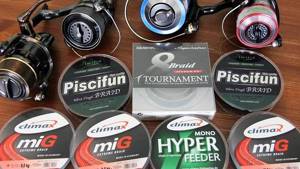
Number of weaving strands
The braided lines currently produced are mostly four or eight wire, respectively PE4 or PE8. Quads are cheaper and more durable; they are simply a braid of four strands. Each vein, in turn, also consists of many threads. Some sources claim that the best braided cord for a feeder is a four-core one, in terms of reliability. In others, the best braid for the feeder is eight-core. The truth, as always, is somewhere in the middle. PE 8 cords are more expensive, they are round and slippery, and provide better range characteristics.

Eights are better calibrated, as they are round in cross-section. PE 4 is simpler, but more reliable. These braids are cheaper, but their cross-section is flat, so the reach when casting is worse. The fours make more noise about the rings when being exhausted. For regular fishing, four-wire is perfect, and such braids are cheaper. That's why most fishermen use them. Eight cores are needed to equip the feeder for long casts and currents. These cords require more maintenance, as they are less resistant to damage from stones and edges. However, if you monitor their condition, treat them with care and use them, they can also last two or three seasons.
The approach is the same - a regular four-core cord will do. If you want to make a more effective and comfortable tackle, we set it to a good eight, but at the same time we pay more attention to checking the braided line for wear, and tie the shock leader more often.
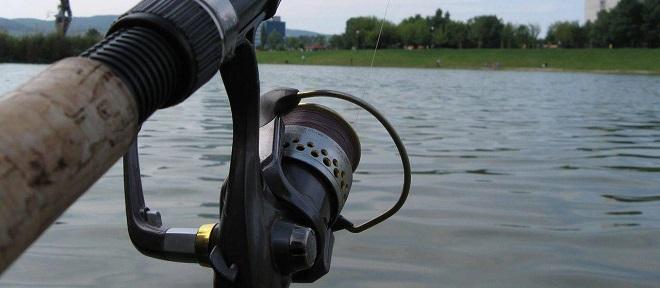
Breaking load and diameter
The braided line for the feeder is selected based on the breaking load. And then the diameter is taken into account. The higher the breaking load for the same diameter, the better. For close picker fishing with feeders up to 30 grams, a sufficient breaking load is 2-3 kg, this corresponds to the thinnest braids. The longer the range is needed and the heavier the feeder, the higher the requirements for the cord. The load increases greatly, and it is better not to increase the thickness of the feeder cord too much - otherwise it will float in the current. Therefore, we select the basis of the equipment according to the breaking load, but taking into account the diameter and other characteristics.
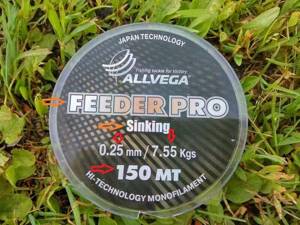
What to look for in labeling
The diameter of the braid for the feeder in light and medium versions is 0.1-0.12 mm, with a breaking load of 5-6 kg. This allows you to use feeders up to 80 grams at a distance of up to 40 meters. If distances beyond that are needed, we use a shock leader, since the braided line cannot be thickened, and the lace may not withstand a power cast with such a breaking load. This is the very limit after which it is better to use high-quality and expensive PE8 braids. Beginner feeders using cheap rods are recommended to use a feeder cord diameter of 0.13-0.14 mm with a load of 7-10 kg. During intensive fishing, thinner braid will begin to cut through the inner inserts of the rings. Fishing rods in the mid-price segment already have Sic rings, which are more resistant to abrasive. Also, such a powerful equipment will forgive beginners mistakes when casting (not fatal ones, which cannot lead to breakage of the quiver tip).
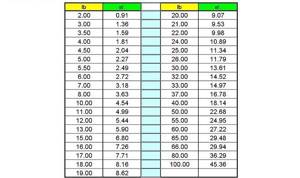
Correspondence table for breaking load Lb (libr) - kilograms
For feeder operators already with experience on more or less serious gear, choosing the diameter of the cord for the feeder, on the one hand, is easier. On medium variants it is 0.1 mm, 5-6 kg, on heavy river fish - 0.12 mm, 7-10 kg. At the same time, torment and research occur not in the area of selecting thickness, but in the quality and wear resistance of the braid. With a diameter of 0.13 mm, the casting range is already significantly reduced compared to about 12 mm. In general, 0.12mm is probably the upper limit for river braided fishing line - provided that a good quality cord with a shock leader is used.
The thickness of the main braid on the feeder in the lightest version is the smallest possible, down to 0.06 mm, 2-3 kg. A cord of this calibration is difficult to find. Only well-known manufacturers will have such a thin diameter wattle fence. For the Chinese, 0.06 mm will most likely actually be 0.12, if not 0.14 mm. However, such a thin rig on a pickerel with light feeders is a killer of roach, bleak and other whitefish during close-in tempo fishing, and is not inferior in catchability to a float rod, even though it is a bottom rod. In addition, with the right equipment, such a feeder can pull out not only small things, but also significant crucian carp, carp or carp. After gaining some fishing experience, the question of what diameter of braid to choose for the feeder usually no longer arises for the angler. The feeder is looking for the best wattle options for wear resistance and reliability.
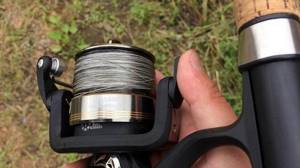
Wear resistance
The issue of reliability and durability of a braided cord for a feeder is an eternal pain for modern doners. This is especially true for amateur fishermen, who have to buy everything with their own money, since there is no box of fishing lines supplied by sponsors in stock. I would like to install the cord for a long time and use it for more than one season. From this point of view, the total cost is cheaper than rewinding low-quality braids two or three times a year. Naturally, all manufacturers claim that their product is the best. The truth can only be discovered through experience of use, as well as through communication with practicing fishermen or on forums. Next, let’s take a closer look at braids, which are popular among feeders precisely based on the criteria of reliability and durability, as well as compliance with the characteristics indicated on the label.
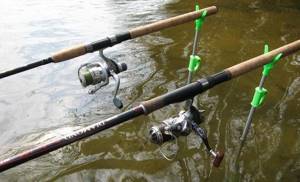
Length
An important point for choosing a feeder braid is the unwinding length. The standard 100 meters is not enough for a feeder. This length is only suitable for short picker tackle. On a medium you need to reel in at least 150 meters, and on Hevik - all 200. With intensive fishing, hooks, breaks, and bandaging of rigs occur. If monofilament fishing line is a cheap consumable, then braided cord is an expensive part of the equipment. Therefore, you need to treat it with care.
However, even with very careful operation, the working length decreases during an intensive season - at a minimum, the shock is tied up and the lower damaged part of the cord is periodically cut off. This is especially true in ponds with stones. Shells and sharp edges. For feeder reels of sizes 4000-6000, this amount of thin braid is not enough. Therefore, we wrap up the backing. At the end of the season, you can unroll the braid by rewinding it in reverse - then the cord will last the next season (if the length allows).
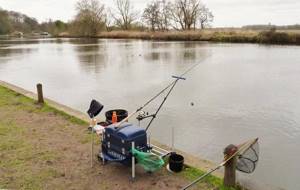
Color
The color of the main cord on the feeder is not for everyone. Usually we use shock with braided wire - for this it is better to choose brown or green braided wire, and in lakes - bluish for camouflage. The rest of the base is located far from the mounting and hook, so any color will do - orange, multicolor, white. This question is not for everyone. In rigs without shock, especially when fishing in shallow water or when the rig is tied directly on the braid, you need to think about masking the cord, since it is directly approaching the feeder. In this case, it is better not to use bright colors.
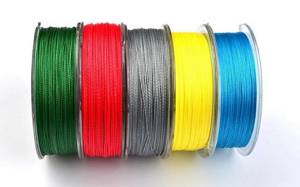
Best Braided Feeder Cords
We will not make a rating of braid for the feeder, but we will consider which cord models are more or less suitable for the angler based on the sum of factors for different equipment options. After long-term experiments on the reservoir, communicating with fishermen and searching for information on the Internet, the answer to the question of which cord is best for the feeder has been found, and it is unambiguous. Of the many options, only three models fall under the concept of the best braid for a feeder in terms of price-quality ratio. The rest are either more expensive or worse in some respects. These are two Japanese Mystic braids from Badger and an American indestructible Strong cord from WFT.
Mystic cords are manufactured in Japan, unwound in Korea, and sold in Russia by Badger. These braids are not yet very common among amateurs - information leaked from athletes. Mystic Sport Max X8 - twitching cord, round, smooth and tear-resistant, holds the clip perfectly. Orange color when unwinding at 150 meters. A diameter of 0.07 mm holds 2.7 kg (picker), 0.10 mm – 5.8 kg (light medium), 0.12 mm – 6.6 kg (Heavy). However, such cords are more suitable for the medium version - 150 meters is still not enough for a heavy-duty cable. The cord is calibrated, meets the specified characteristics, and has excellent sensors. Special protective impregnation provides high abrasive resistance.

Mystic Hyper Cast Game is a multicolor cord with similar characteristics, unwinding is 200 meters, which is good for heavy long-range river boaters. Diameters for feeder:
- 0.09mm – 3.8 kg;
- 0.12mm – 5.6 kg;
- 0.13mm – 6.5 kg.
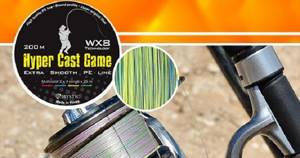
The approximate price tag is 1800-2000 rubles for 150 and 200 meters, which is about the same as the manufacturers of high-quality cords familiar to amateurs. In the segment you can also find more expensive braids, approximately the same in quality, with a slightly higher breaking load - but why? Among other manufacturers in the segment up to 2000 rubles. beyond 200 meters there are also good cords (more on them later), but somewhere or in some way they fall short - either worse in wear resistance, or thicker than the stated diameter, but usually they quickly fray during intensive fishing. Mystic is a relatively wear-resistant braid. With care they will last for several seasons.
The third monster among feeder braids, which is difficult for competitors to get close to, is the Strong New cord from WFT, widely known abroad but not very popular here. These lines are usually used for sea fishing; many famous foreign fishermen fish with these braids, probably for good reason. This is a real indestructible line - it does not fray on stones (it is specially designed for such fishing at sea), it does not fluff, but the main advantage is its tensile strength.
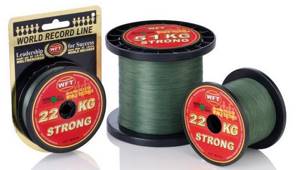
With a diameter of 0.08 mm, the breaking load is 10 kg, 0.12 mm - 15 kg (!). No other manufacturer has such characteristics, and the diameters and kilograms correspond to reality. The difficulty is in one thing - this cord is almost not on the shelves of our stores, so few people know about them. However, recently WFT cords have begun to appear on our market. The price is normal - approximately 1,700 rubles for 150 meters, there are unwindings of 300 and 500 meters.
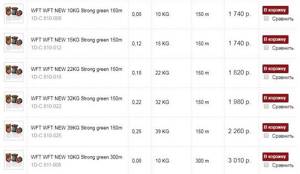
Showcase screen – unwinding and prices
More familiar braids, which have also proven themselves well among feeders based on reviews and information from fishing forums:
- Allvega Feeder Braid;

- Daiwa Tournament Braid;
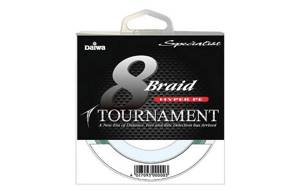
- Berkley Whiplash Pro (thicker than advertised);
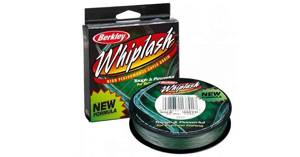
- Power Pro Moss Green (original, there are many low-quality fakes on the market);
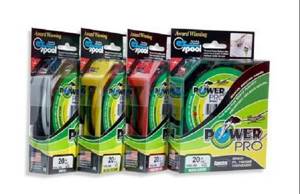
- Sunline Super PE;
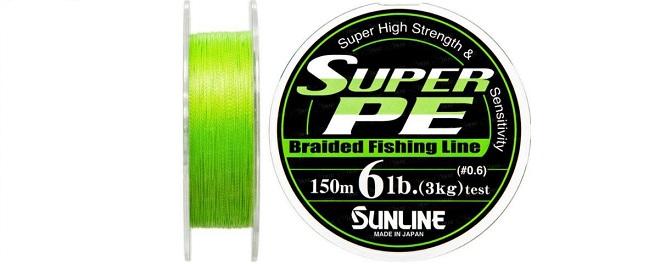
- Cheap and relatively high-quality Chinese Piscifun Brad, Max Power Seaknight and KastKing from aliexpress - 4PE in reels up to 1000 meters. Suitable for backing, entry level and simple fishing conditions. This is the best choice for an amateur due to the ridiculous price and at the same time sufficient quality. Read more below.
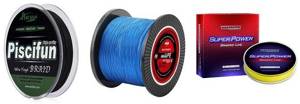
Braided feeder from Aliexpress
Above are considered almost ideal options in terms of the strength of the fence. However, equipping the feeder with advanced cord models comes at a cost. Under normal conditions, for an amateur feeder, a simple 4-core braid from Aliexpress is enough at a price 10 (!) times cheaper than leading brands. At the same time, the wattle fence is normal for its cost - the diameter is adequate, and in terms of endurance - it lasts for a season or two, depending on the intensity of use.
I personally (the author of the article) have been intensively racing Max Power 2 at 10 lb for the third season, I take 1000 meters each - enough for two medium feeders and a picker, I fill Tsurinoya 2500 (picker), Shimano Nexave 4000 (feeder) reels completely without backing (price it's funny). The braid is enough for a season - there are no shoots, it does not fray, but fades. I don't mind throwing it away and putting in a new one next year. The reels are also from Ali - original Malaysian assembly, much cheaper than in a fishing store, Shimano added a bearing instead of a bushing, again from Aliexpress.
Thin diameters with a tensile load of 10-15 Lb are suitable for the feeder. This cord holds up well to close casting with feeders up to 60 grams. For power casts and heavy feeders, we install a shock leader from the same fence with a load of 20-30 lb. In the vastness of Ali, two cords are leading in this matter - Kastking Super Power, about 400 rubles for 300 meters, as well as SeaKnight Max Power II - in unwindings of 300, 500 and 1000 meters. For example, for a kilometer of such a fence you need to pay about 1,200 rubles (while for 150 meters of the top ones from Dive, WFT or Mystic, described at the beginning of the article - more than 2,000 rubles).
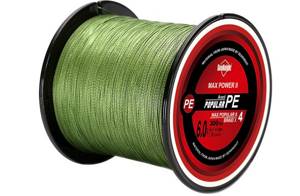
Sea Knight MAX POWER II

Screenshot from the store
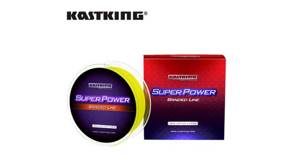
Kast King Super Power
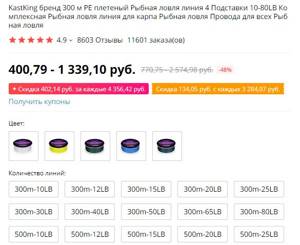
Screenshot from the Cast King store
It turns out that it is more than 10 times cheaper. If you use a fundamentally expensive branded wicker as a working tool, then this one itself begs to be used for backing, cheap and cheerful.
Naturally, you need to buy only in official stores with five stars and a bunch of reviews (those who shop at Ali already know this). At the moment, this is the cheapest option for braiding a feeder of acceptable quality. which can be found at all.
Links to verified Aliexpress stores for the described and some other good cords (pictures are clickable):
View on Aliexpress:
Link to KastKing store
SeaKnight Store Link
Rod equipment
We immediately wind the working cord onto a special small feeder spool. For a deep spool - with backing. For comfortable winding with backing, you need two identical spools. We tie a working fence to the first one, wind it 150-200 meters, tie it with a carrot or a backing knot. Then we wind it so that there is 1.5-2 mm left to the side of the spool. If it’s more, the line will start to fall off and get tangled; if it’s less, the casting range will be worse due to the increase in friction force when casting. Now you need to turn the cord over. We put a working empty spool on the reel and rewind it, the working cord will be on top. You need to wind the braid onto the feeder reel tightly so that the laying is uniform - correct casting depends on this. More information about feeder coils:
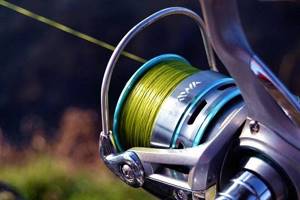
To make reeling more convenient, you can ask someone to hold the spool of fishing line, or use a special machine. You need to wind so that the cord fits onto the spool under a slight force. If you wind the braid wet and with a little force, the styling will be even better. To do this, the reel can be placed in a container of water. To properly wind braid onto the reel of a feeder rod, you need to do everything without haste and without rushing. Feeders usually rewind fishing lines in the spring, before the start of the season.
Some feeder montages can be knitted directly onto the main braid or shock leader, while others are better done as separate strands. Installation of feeder equipment is a separate big topic for discussion. More information about the installation of feeder gear:
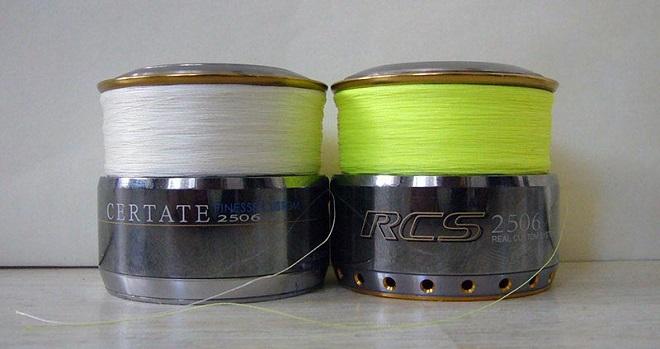
Shock leader
Even good abrasion-resistant braid will not withstand the impact of sharp shell edges, stones and other debris. In such conditions, a shock leader must be installed to protect the main fence, even if light feeders are used. It’s easier to change the shock every time than to cut off damaged pieces of expensive braid. To place the shock leader on the feeder cord, use a carrot knot or a regular counter knot. The main thing is that the knot is small and neat so that it fits well through the rod guides when casting. Learn more about how to install a shock leader on a feeder.
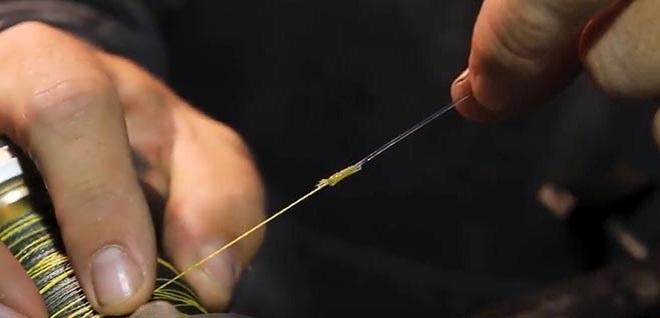
Leash cushioning
The braided feeder cord makes the equipment rigid and not shock-absorbing. This is good for fixing a bite, but bad for playing large fish on thin leashes. The ability to work with the reel's clutch, as well as the feeder - a piece of elastic in the form of an insert between the leash and the main mounting - can help when fishing. Read more about feeders in the installation of feeder equipment.
